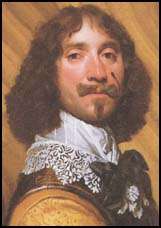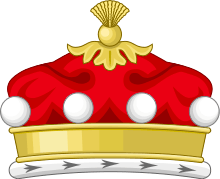John Byron, 1st Baron Byron
| John Byron, Lord Byron KB | |
|---|---|
 Lord Byron | |
| Born | 1599 |
| Died | 23 August 1652 |
| Title | 1st Baron Byron |
| Spouse(s) | Cecilia West, Eleanor Needham |
| Parent(s) |
Sir John Byron Anne Molyneux |
John Byron, 1st Baron Byron KB (1599, Newstead, Nottinghamshire – 23 August 1652) was an English nobleman, Royalist, politician, peer, knight, and supporter of Charles I during the English Civil War.
Life
Byron was the son of Sir John Byron (died 1623) and Anne Molyneux. He was educated at Trinity College, Cambridge.[1] He succeeded his father in 1625.
He was elected as MP for Nottingham in 1624 and 1626. He was knighted (KB) in 1626 and was then elected as knight of the shire (MP) for Nottinghamshire in 1628. He also served as High Sheriff of Nottinghamshire for 1634 and then as Lieutenant of the Tower of London, from December 1641 to February 1642.
When the Civil War started, he joined the king at York. He was engaged on the Royalists' cause throughout the Civil Wars and afterwards. After Byron distinguished himself at the First Battle of Newbury King Charles created him Baron Byron in October 1643 and made him commander of the Royalist forces in Lancashire and Cheshire. However he was defeated at the Battle of Nantwich in 1644 and forced to withdraw to Chester. He then marched with Prince Rupert’s forces into Yorkshire and commanded the royalist right flank at the Battle of Marston Moor in July 1644, but after his troops were routed by numerically superior parliamentarian forces he retreated to Carnarvon and resigned his command. He did, however, defend Carnarvon Castle ably for the Royalist cause, withstanding long sieges before finally surrendering it to Parliamentary forces in 1646.
Lord Byron died in 1652, childless, in exile in Paris, and was succeeded by his next eldest brother Richard Byron, 2nd Baron Byron (born 1606).
Family
Lord Byron married firstly Cecilia West, daughter of Thomas West, 3rd Baron De La Warr and secondly Eleanor (1627–1664) daughter of Robert Needham, 2nd Viscount Kilmorey. Eleanor was famous for her beauty; Peter Lely painted her as St. Catherine, as depicted here; and according to the diarist Samuel Pepys she was the 17th mistress of Charles II.[2]
Arms
  |
|
Notes
- ↑ "Byron, John (BRN615J)". A Cambridge Alumni Database. University of Cambridge.
- ↑ Wheatley 1893, Diary of Samuel Pepys: 26 April 1667 & endnote 6.
References


- Watson, Paula; Ferris, John. P. (2010). "Byron, John (1599–1652), of Newstead Abbey, Notts.". In Thrush, Andrew; Ferris, John P. The History of Parliament: the House of Commons 1604–1629,. Cambridge University Press.
- Wheatley, Henry, ed. (1893). "Diary of Samuel Pepys: 26 April 1667 & endnote 6". Diary of Samuel Pepys. London: George Bell & Sons.
External links
- Plant, David. "Sir John Byron, Lord Byron". British Civil Wars website.
| Parliament of England | ||
|---|---|---|
| Preceded by Michael Purefoy George Lascelles |
Member of Parliament for Nottingham 1624–1625 With: Sir Charles Cavendish |
Succeeded by Robert Greaves John Martyn |
| Preceded by Robert Greaves John Martyn |
Member of Parliament for Nottingham 1626 With: Sir Gervase Clifton |
Succeeded by Sir Charles Cavendish Viscount Newark |
| Preceded by Sir Henry Stanhope Sir Thomas Hutchinson |
Member of Parliament for Nottinghamshire 1628–1629 With: Sir Gervase Clifton |
Succeeded by Parliament suspended until 1640 |
| Peerage of England | ||
| New creation | Baron Byron 1643–1652 |
Succeeded by Richard Byron |